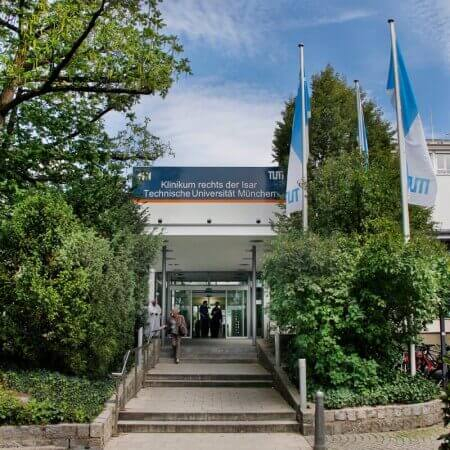Ovarian teratoma or mature cystic teratoma belongs to the germ cell tumors.
The main cause of the development of tumors is a violation of the normal maturation of embryo tissues. Such a phenomenon leads to the fact that the germ cell tumors contain the embryonic rudiments of several organs that may be located far from this anatomical structure. This way, ovarian tumors can consist of muscle, bone tissues, and have the elements of primitive organs in their structure.
Content
- Why do ovarian teratomas occur?
- What are the symptoms of ovarian teratoma?
- Diagnosis
- Treatment of ovarian teratoma
- After surgery
- Ovarian teratoma and fertility
- Prognosis
- Where to undergo cancer treatment in Germany?
- Cost of treatment
- How to go for cancer treatment in Germany?
Why do ovarian teratomas occur?
Teratomas are tumors formed during the pregnancy and therefore consist of embryo cells.
One of the most likely causes of the development of teratogenic ovarian tumors is anomalous embryogenesis which is a consequence of chromosomal abnormalities. Simply put, the main cause of ovarian tumor formation is the pathological maturation of tissues of the future fetus. That is why such tumors have signs of some organs which should not be present in the specific anatomical structure. Often, ovarian teratomas contain small elements or particles of skin, hair, muscles, or nervous and lymphatic tissues.
These tumors are considered benign. However, experts note that in some cases the tumor can undergo a malignant transformation and invade the surrounding tissues. Then the removal of ovarian tumors becomes a more complex task for doctors.
What are the symptoms of ovarian teratoma?
For mature tumors, the asymptomatic clinical course or mild clinical manifestations are typical. Teratomas often become an accidental finding during examination for other reasons. They can also manifest themselves with mild pulling or bursting pain in the lower abdomen that resembles period pain in women. With large ovarian tumors, increased abdomen, frequent urination or difficulty urinating and defecation are possible. An increase in the size of the abdomen is most typical for patients with asthenic physique. The menstrual cycle is not disturbed.
Sometimes ovarian teratomas are first detected in women after pregnancy. This may be due to the acceleration of the growth of the neoplasm against the background of hormonal changes, increased pressure on the uterus and pelvic organs, or torsion of the teratoma stem. Torsion of the stems of the ovarian tumors is accompanied by intense pain. It is a medical emergency requiring surgery.
In the absence of timely medical help, necrosis of the ovarian teratoma wall is possible. It is followed by rupture of the cyst with the spreading of its contents into the abdominal cavity and the development of peritonitis. In pregnant women, torsion of the cyst stem can lead to fertility problems, miscarriage, or premature birth. Ovarian teratomas in pregnant and non-pregnant patients can also lead to the development of the inflammatory process that is manifested by severe pain, weakness, and an increase in body temperature.
With immature teratomas, fatigue and pain in the lower abdomen along with other symptoms are observed. At the advanced stages of malignant teratomas, patients suffer from cancer intoxication in combination with dysfunctions of organs affected by distant metastases. Most often, metastases in the lungs are detected.
Diagnosis
With a vaginal-abdominal or recto-abdominal gynecological study, the ovarian tumors are palpable in the form of an elastic, rounded, and painless formation, that is located above the uterus or on the side of the uterus.
In gynecology, for the diagnosis of ovarian tumors patients undergo ultrasound scan of small pelvic organs with a transvaginal and transabdominal transducer. During the ultrasound scan, the size of tumors, the intensity of their blood supply, and the echo density of its contents are assessed. In doubtful situations, the diagnosis of mature cystic teratomas is confirmed with the help of computed tomography and MRI.
In patients with the complicated ovarian tumors, laparoscopy is performed. Blood tests for tumor markers are necessarily prescribed to women with suspicion for ovarian teratoma. This makes it possible to determine whether a tumor is malignant or benign. In the process of diagnosis making, the mature cystic teratomas are differentiated from other types of cysts and malignant ovarian tumors.
Treatment of ovarian teratoma
The first-line approach to cancer treatment in the case of ovarian teratomas is carrying out surgery. The volume of surgery depends on the size and localization of tumors, the presence of complications, the age of patients, etc.
There are different methods of performing surgery. However, if patients complain of severe complications connected with ovarian tumors, there’s only one optimal approach to surgery, i.e. to conduct surgery immediately.
In other cases, the choice of specific surgery depends on the size and the localization of tumors. In most cases, laparoscopy is used. This is a minimally invasive surgery during which small cuts are made in the abdominal wall and millimeter tools and video camera are introduced through them into the abdominal cavity. During the laparoscopy ovarian tumors can be studied and, if necessary, removed.
There are two basic approaches to performing surgery for ovarian teratoma, i.e. laparoscopy and laparotomy.
Laparoscopic surgery causes a minimal injury to the tissues during the excision of the formation in the ovary. The approach is effective with tumors that haven't reached 5 cm in size. The duration of manipulation is no more than an hour. In 3-5 days after the procedure, a woman is discharged from the hospital. However, not all ovarian tumors can be removed using laparoscopic surgery. For women with large formations or if there is a suspicion for a malignant tumor, a cut of the abdominal wall is required.
Based on the required volume of the intervention, the ovary may be preserved or may be removed.
Removal of the malignant tumor of the ovary with maximum sparing of healthy ovarian tissue is indicated to young patients who want to preserve the reproductive potential. The incision of the ovarian tissue is made very carefully, in order not to damage the capsule teratomas are usually surrounded with. The blood vessels in the region of surgery are coagulated. Pregnancy planning is recommended to patients no earlier than one year after surgery.
Removal of the ovary together with a fallopian tube is prescribed to women during menopause. Such a volume of surgery is connected with lower risks of the subsequent malignant process. Surgery is carried out laparoscopically or via laparotomy. Recovering after surgery is almost painless; patients can be active already 2-3 hours after the surgery. The period of postoperative hospitalization recommended for women is 1-2 days. Patients can plan pregnancy in 3-6 months after surgery.
In most cases, surgery allows to maintain the usual lifestyle, and the risk of malignant recurrence is virtually reduced to zero.
After surgery
After the surgery, patients receive conservative therapy. Vitamins and minerals, and anti-inflammatory agents help patients to recover quicker.
To prevent the malignant relapse, a healthy lifestyle with refusal from alcohol and smoking is recommended. The diet also has a beneficial effect on patients’ recovery after cancer treatment. After ovarian teratoma treatment, patients need to exclude fatty foods, eat more food enriched with retinol, selenium-containing food, products rich with phosphorus and potassium.
Women planning to conceive must undergo the follow-up examinations. All patients who underwent therapy need to visit the gynecologist once every six months.
Ovarian teratoma and fertility
As a rule, ovarian teratomas of small size do not cause discomfort in pregnant women and do not cause violations of the child's intrauterine development. However, with an increase in teratoma size, complications may arise. In this case, urgent surgery is required.
If an ovarian teratoma of fewer than 5 centimeters in size is detected during pregnancy, a woman needs continuous follow-up. With a larger neoplasm or in the case of its growth, surgery is required.
To prevent possible malignant relapse when conducting a C-section, a teratoma is removed simultaneously. With natural delivery, patients undergo planned cancer treatments or surgeries to remove cysts.
Hormone fluctuations during pregnancy may provoke the malignant transformation. Moreover, both malignant and benign tumors can compress organs in the abdominal cavity, which can cause different complications, including fertility problems.
Prognosis
With timely removal, the prognosis for patients with ovarian teratoma is favorable. The malignant recurrence occurs rarely. After the surgery, preventative examinations with visiting the gynecologist and undergoing ultrasound scan are recommended for patients twice a year.
Where to undergo cancer treatment in Germany?
Leading German hospitals to undergo ovarian cancer treatment in are:
- University Hospital Rechts der Isar Munich
- University Hospital Tuebingen
- Leverkusen Clinic
- University Hospital Ulm
- University Hospital Carl Gustav Carus Dresden
Feel free to check out the profiles of mentioned German hospitals on the Booking Health website.
Cost of treatment
The price for cancer treatment or the overall cost of treatment in German hospitals is calculated separately in each specific situation. The stage of the malignant process, the complexity of its treatment, and the number of procedures involved in cancer treatment are all taken into account.
The cost of treatment in Germany depends on its type and duration. In oncology, predicting the whole course of therapeutic measures in advance is very difficult. Therefore, accurately calculating the upcoming costs is also hard.
The prices for ovarian teratoma diagnostics in German hospitals start at 584 EUR. The cost of treatment with surgery in German hospitals starts at 2,200 EUR. The price for cancer rehabilitation starts at 951 EUR per day.
To get a consultation on the cost of treatment in your case, leave a request on the Booking Health website.
How to go for cancer treatment in Germany?
Many cancer patients ask this question, knowing that Germany is the leader in successful cancer treatment.
Going abroad for treatment is a step-by-step process, and a misstep at any of the stages can make patients start over. For this not to happen, patients trust Booking Health with organizing their treatment abroad.
Booking Health works with the best German hospitals to provide clients with the most effective cancer care. Besides, for your comfort Booking Health deals with all organizational issues that may arise during the arrangement of cancer treatment in Germany.
You can leave a request on the Booking Health website to begin a journey towards your recovery.
Authors:
The article was edited by medical experts, board certified doctors Dr. Vadim Zhiliuk and Dr. Sergey Pashchenko. For the treatment of the conditions referred to in the article, you must consult a doctor; the information in the article is not intended for self-medication!
Sources:
National Center for Biotechnology
Centers for Disease Control and Prevention




















